warning YAMAHA TTR50 2006 Notices Demploi (in French)
[x] Cancel search | Manufacturer: YAMAHA, Model Year: 2006, Model line: TTR50, Model: YAMAHA TTR50 2006Pages: 390, PDF Size: 9.69 MB
Page 164 of 390
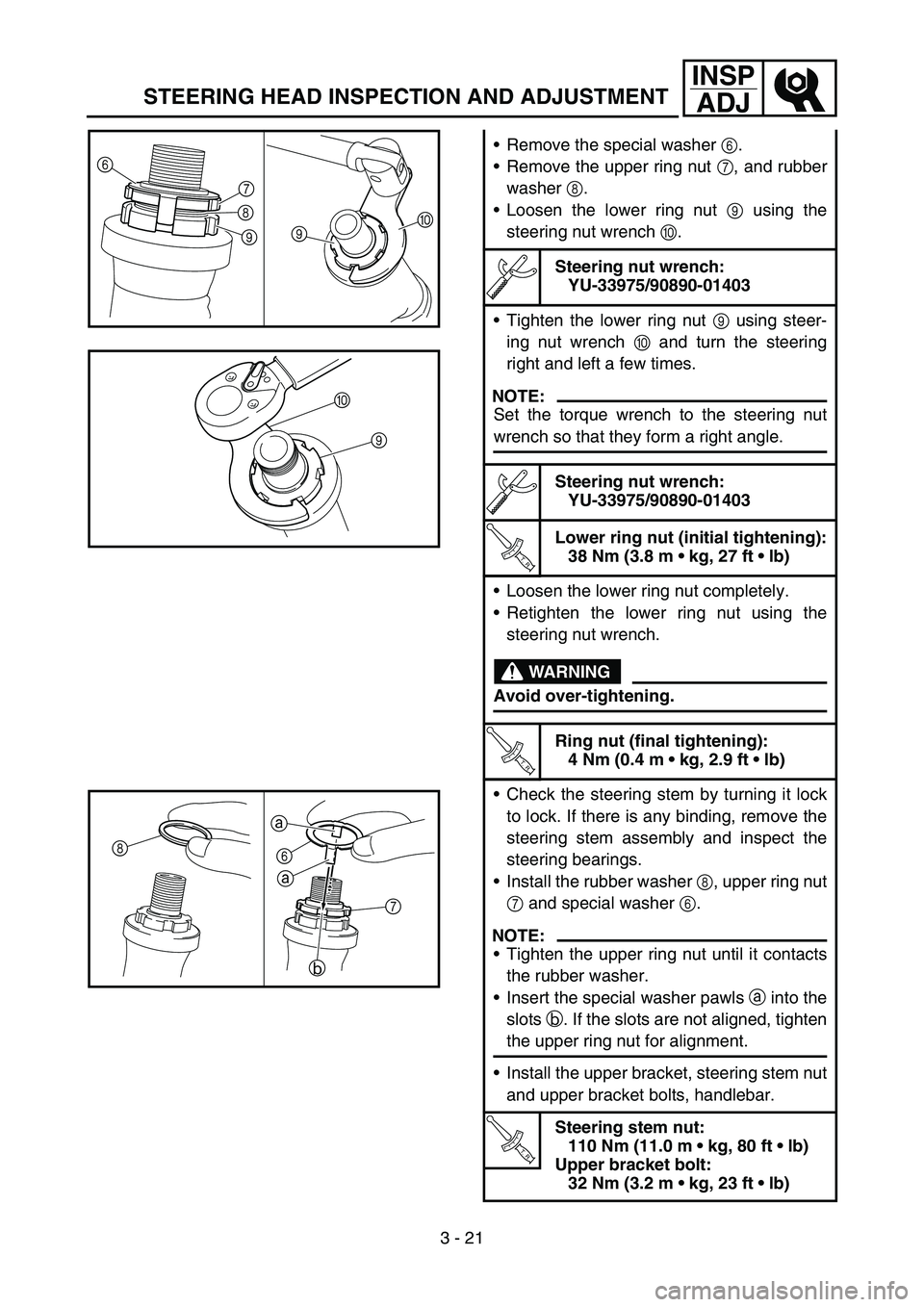
3 - 21
INSPADJ
STEERING HEAD INSPECTION AND ADJUSTMENT
Remove the special washer 6.
Remove the upper ring nut 7, and rubber
washer 8.
Loosen the lower ring nut 9 using the
steering nut wrench 0.
Steering nut wrench:
YU-33975/90890-01403
Tighten the lower ring nut 9 using steer-
ing nut wrench 0 and turn the steering
right and left a few times.
NOTE:
Set the torque wrench to the steering nut
wrench so that they form a right angle.
Steering nut wrench: YU-33975/90890-01403
T R..
Lower ring nut (initial tightening):38 Nm (3.8 m kg, 27 ft lb)
Loosen the lower ring nut completely.
Retighten the lower ring nut using the
steering nut wrench.
WARNING
Avoid over-tightening.
T R..
Ring nut (final tightening):
4 Nm (0.4 m kg, 2.9 ft lb)
Check the steering stem by turning it lock
to lock. If there is any binding, remove the
steering stem assembly and inspect the
steering bearings.
Install the rubber washer 8, upper ring nut
7 and special washer 6.
NOTE:
Tighten the upper ring nut until it contacts
the rubber washer.
Insert the special washer pawls a into the
slots b. If the slots are not aligned, tighten
the upper ring nut for alignment.
Install the upper bracket, steering stem nut
and upper bracket bolts, handlebar.
T R..
Steering stem nut:
110 Nm (11.0 m kg, 80 ft lb)
Upper bracket bolt: 32 Nm (3.2 m kg, 23 ft lb)
7
8
\b
6
0
\b
0
\b
86
7
a
a
b
Page 170 of 390
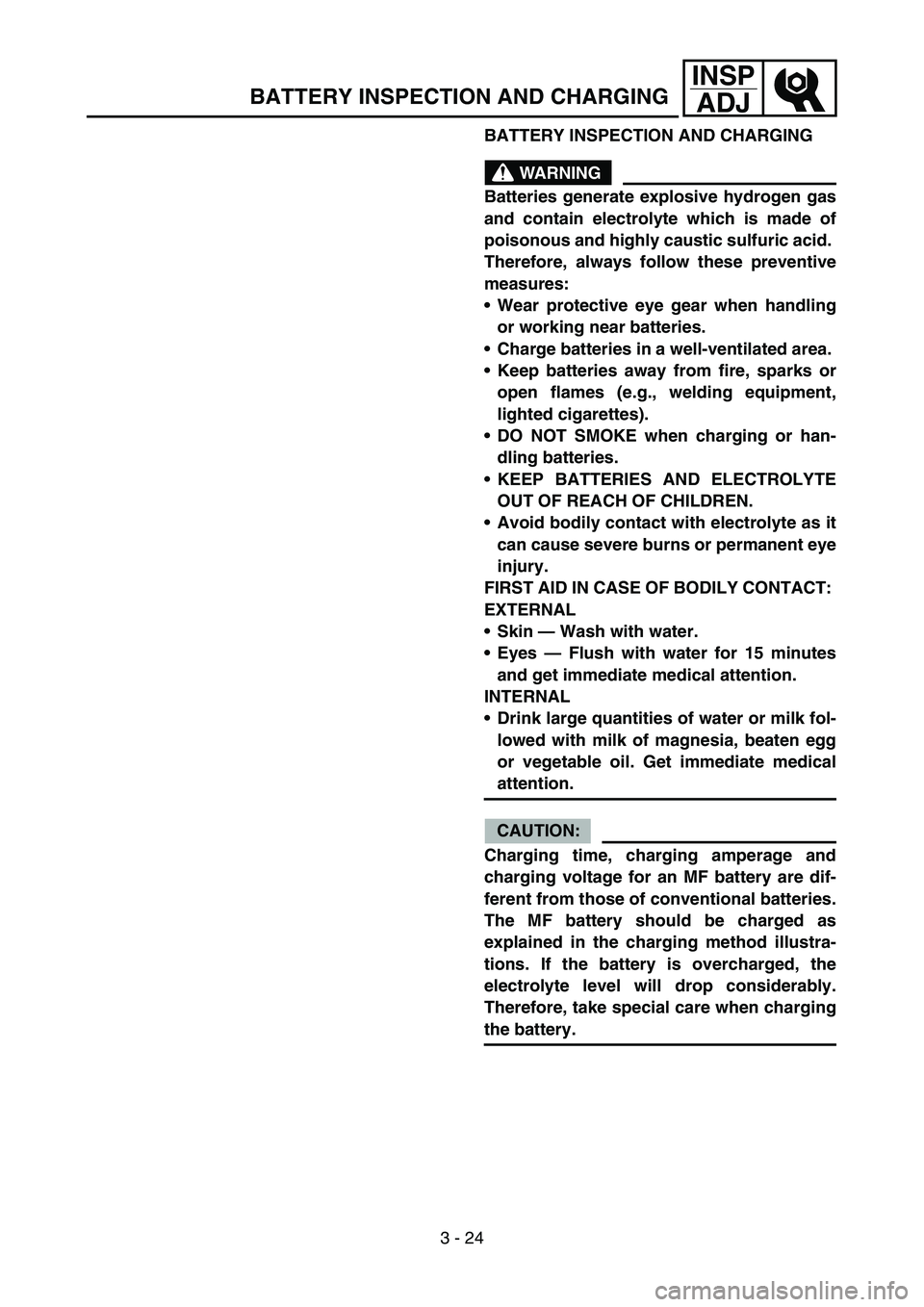
3 - 24
INSPADJ
BATTERY INSPECTION AND CHARGING
WARNING
Batteries generate explosive hydrogen gas
and contain electrolyte which is made of
poisonous and highly caustic sulfuric acid.
Therefore, always follow these preventive
measures:
Wear protective eye gear when handling
or working near batteries.
Charge batteries in a well-ventilated area.
Keep batteries away from fire, sparks or
open flames (e.g., welding equipment,
lighted cigarettes).
DO NOT SMOKE when charging or han-
dling batteries.
KEEP BATTERIES AND ELECTROLYTE
OUT OF REACH OF CHILDREN.
Avoid bodily contact with electrolyte as it
can cause severe burns or permanent eye
injury.
FIRST AID IN CASE OF BODILY CONTACT:
EXTERNAL
Skin — Wash with water.
Eyes — Flush with water for 15 minutes
and get immediate medical attention.
INTERNAL
Drink large quantities of water or milk fol-
lowed with milk of magnesia, beaten egg
or vegetable oil. Get immediate medical
attention.
CAUTION:
Charging time, charging amperage and
charging voltage for an MF battery are dif-
ferent from those of conventional batteries.
The MF battery should be charged as
explained in the charging method illustra-
tions. If the battery is overcharged, the
electrolyte level will drop considerably.
Therefore, take special care when charging
the battery.
BATTERY INSPECTION AND CHARGING
Page 174 of 390
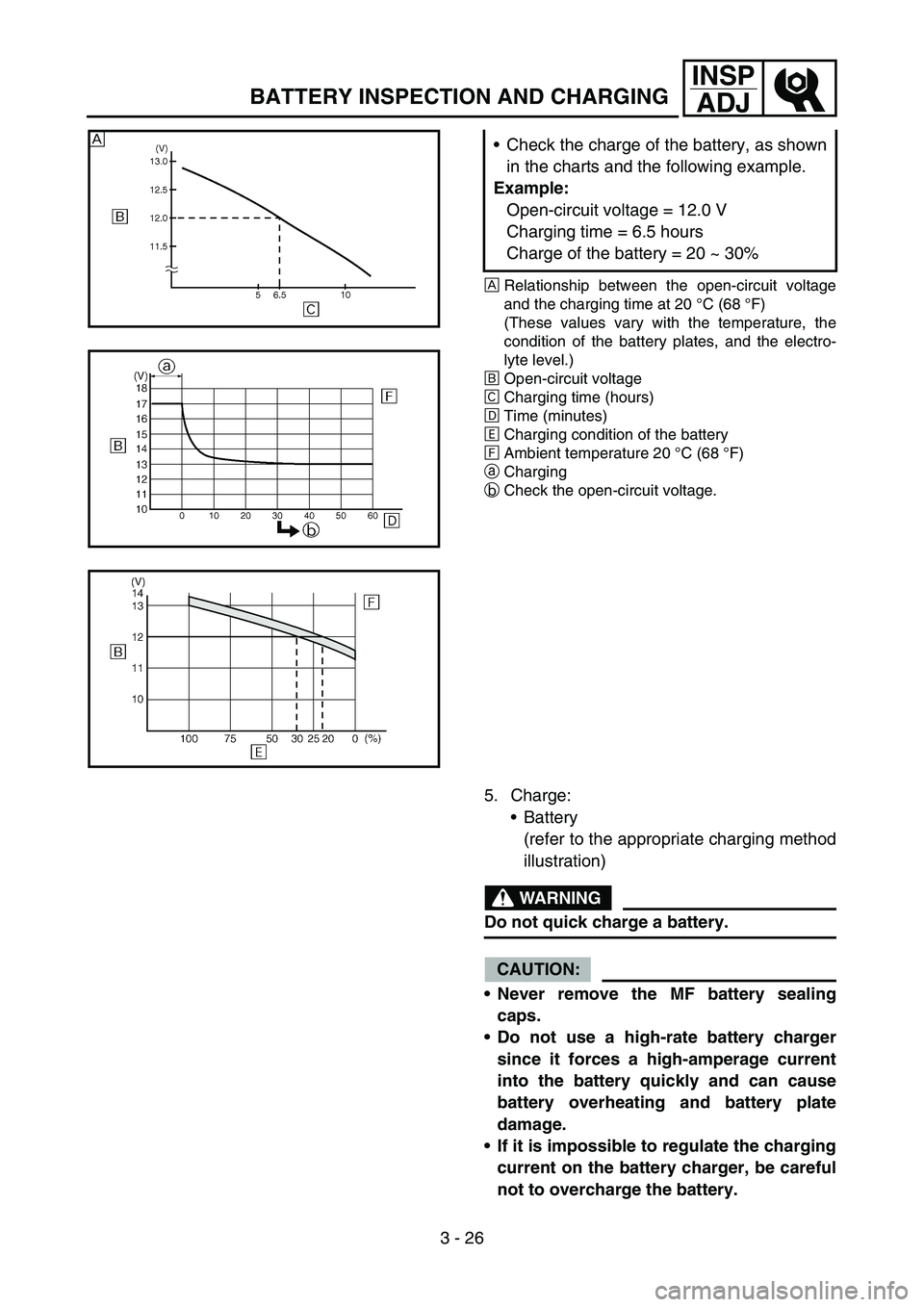
3 - 26
INSPADJ
BATTERY INSPECTION AND CHARGING
È Relationship between the open-circuit voltage
and the charging time at 20
°C (68 °F)
(These values vary with the temperature, the
condition of the battery plates, and the electro-
lyte level.)
É Open-circuit voltage
Ê Charging time (hours)
Ë Time (minutes)
Ì Charging condition of the battery
Í Ambient temperature 20
°C (68 °F)
a Charging
b Check the open-circuit voltage.
Check the charge of the battery, as shown
in the charts and the following example.
Example:
Open-circuit voltage = 12.0 V
Charging time = 6.5 hours
Charge of the battery = 20 ~ 30% È
5. Charge: Battery
(refer to the appropriate charging method
illustration)
WARNING
Do not quick charge a battery.
CAUTION:
Never remove the MF battery sealing
caps.
Do not use a high-rate battery charger
since it forces a high-amperage current
into the battery quickly and can cause
battery overheating and battery plate
damage.
If it is impossible to regulate the charging
current on the battery charger, be careful
not to overcharge the battery.
Page 186 of 390
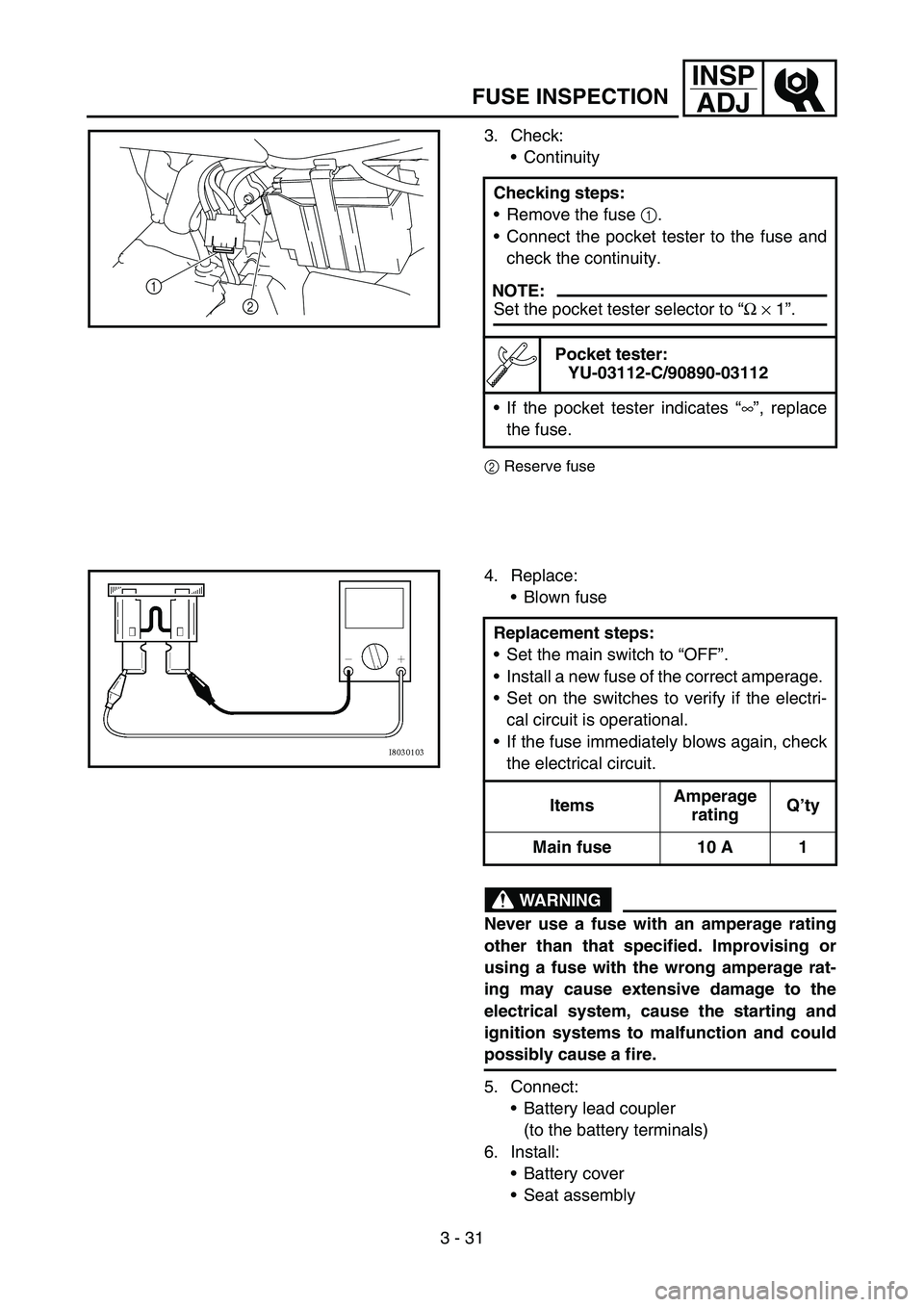
3 - 31
INSPADJ
FUSE INSPECTION
3. Check:
Continuity
2 Reserve fuse
Checking steps:
Remove the fuse 1
.
Connect the pocket tester to the fuse and
check the continuity.
NOTE:
Set the pocket tester selector to “Ω × 1 ”.
Pocket tester:
YU-03112-C/90890-03112
If the pocket tester indicates “∞ ”, replace
the fuse.
1 2
4. Replace:
Blown fuse
WARNING
Never use a fuse with an amperage rating
other than that specified. Improvising or
using a fuse with the wrong amperage rat-
ing may cause extensive damage to the
electrical system, cause the starting and
ignition systems to malfunction and could
possibly cause a fire.
5. Connect:
Battery lead coupler
(to the battery terminals)
6. Install: Battery cover
Seat assembly
Replacement steps:
Set the main switch to “OFF ”.
Install a new fuse of the correct amperage.
Set on the switches to verify if the electri-
cal circuit is operational.
If the fuse immediately blows again, check
the electrical circuit.
Items Amperage
rating Q
’ty
Main fuse 10 A 1
Page 204 of 390
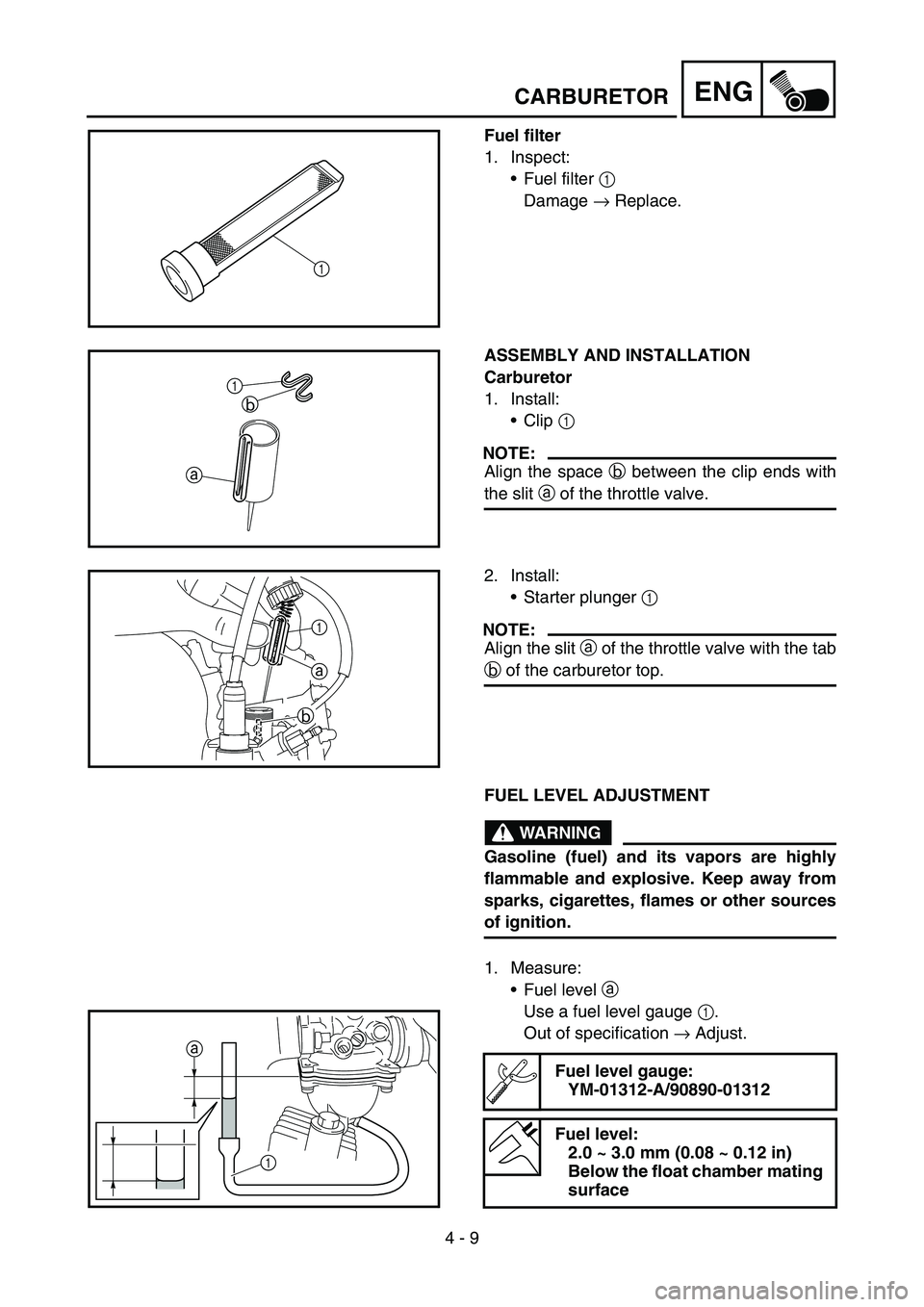
4 - 9
ENGCARBURETOR
Fuel filter
1. Inspect:Fuel filter 1
Damage → Replace.
1
ASSEMBLY AND INSTALLATION
Carburetor
1. Install:
Clip 1
NOTE:
Align the space b between the clip ends with
the slit a of the throttle valve.
1
a
b
2. Install: Starter plunger 1
NOTE:
Align the slit a of the throttle valve with the tab
b of the carburetor top.
1
ba
FUEL LEVEL ADJUSTMENT
WARNING
Gasoline (fuel) and its vapors are highly
flammable and explosive. Keep away from
sparks, cigarettes, flames or other sources
of ignition.
1. Measure:
Fuel level a
Use a fuel level gauge 1.
Out of specification → Adjust.
Fuel level gauge:
YM-01312-A/90890-01312
Fuel level:2.0 ~ 3.0 mm (0.08 ~ 0.12 in)
Below the float chamber mating
surface
a
1
Page 302 of 390

5 - 1
CHAS
EC500000
CHASSIS
FRONT WHEEL AND REAR WHEEL
FRONT WHEEL AND FRONT BRAKE
Extent of removal:1 Front wheel removal
2 Wheel bearing removal
3 Brake shoe plate assembly removal and disassembly
Extent of removal Order Part name Q ’ty Remarks
FRONT WHEEL REMOVAL
WARNING
Support the machine securely so
there is no danger of it falling over.
Preparation for removal Hold the machine by placing the
suitable stand under the engine.
1 Front brake adjuster 1
2Pin 1
3Spring 1
4 Locknut 1
5 Brake cable 1 Disconnect at the lever side.
6 Front fork guard (left) 1
7 Front fork guard (right) 1
8 Wheel axle nut 1
9 Front wheel axle 1
21
FRONT WHEEL AND REAR WHEEL
Page 306 of 390
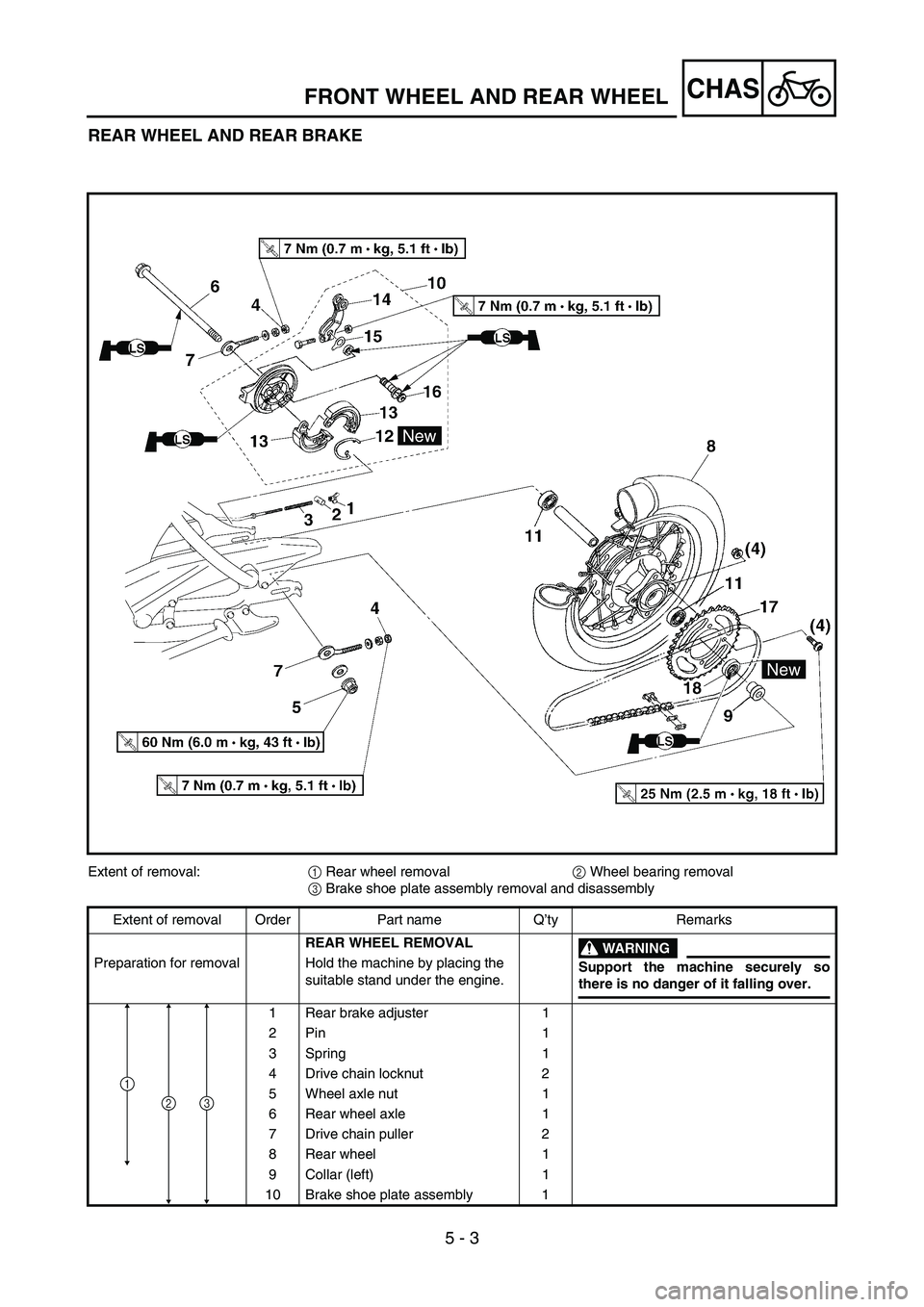
5 - 3
CHASFRONT WHEEL AND REAR WHEEL
REAR WHEEL AND REAR BRAKE
Extent of removal:1 Rear wheel removal
2 Wheel bearing removal
3 Brake shoe plate assembly removal and disassembly
Extent of removal Order Part name Q ’ty Remarks
REAR WHEEL REMOVAL
WARNING
Support the machine securely so
there is no danger of it falling over.
Preparation for removal Hold the machine by placing the
suitable stand under the engine.
1 Rear brake adjuster 1
2Pin 1
3Spring 1
4 Drive chain locknut 2
5 Wheel axle nut 1
6 Rear wheel axle 1
7 Drive chain puller 2
8 Rear wheel 1
9 Collar (left) 1
10 Brake shoe plate assembly 1
2
1
3
Page 312 of 390
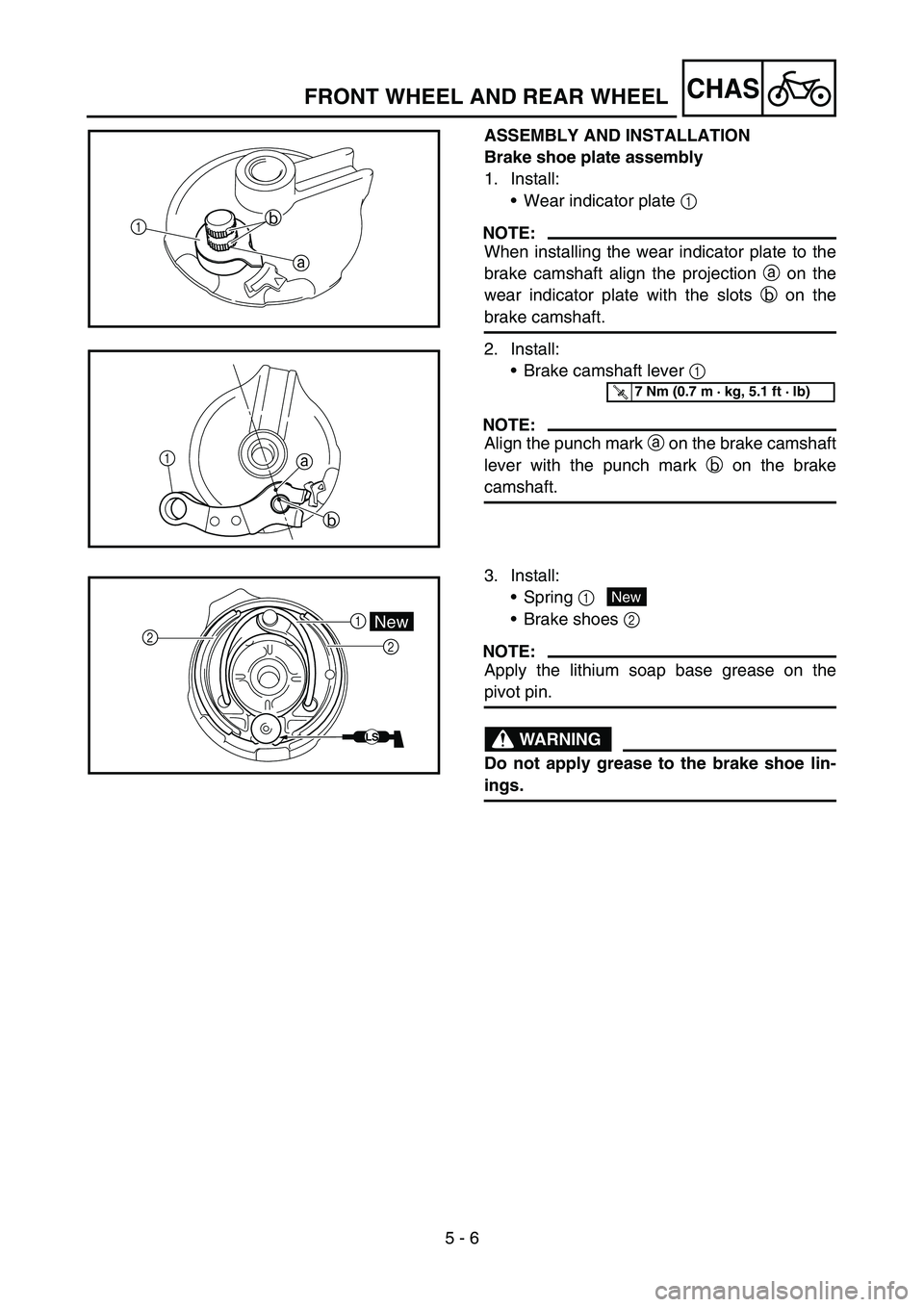
5 - 6
CHAS
ASSEMBLY AND INSTALLATION
Brake shoe plate assembly
1. Install:Wear indicator plate 1
NOTE:
When installing the wear indicator plate to the
brake camshaft align the projection a on the
wear indicator plate with the slots b on the
brake camshaft.
2. Install:
Brake camshaft lever 1
NOTE:
Align the punch mark a on the brake camshaft
lever with the punch mark b on the brake
camshaft.
b
1
a
1a
b
T R..7 Nm (0.7 m · kg, 5.1 ft · lb)
3. Install:
Spring 1
Brake shoes 2
NOTE:
Apply the lithium soap base grease on the
pivot pin.
WARNING
Do not apply grease to the brake shoe lin-
ings.
1
2
2
LS
New
New
FRONT WHEEL AND REAR WHEEL
Page 322 of 390
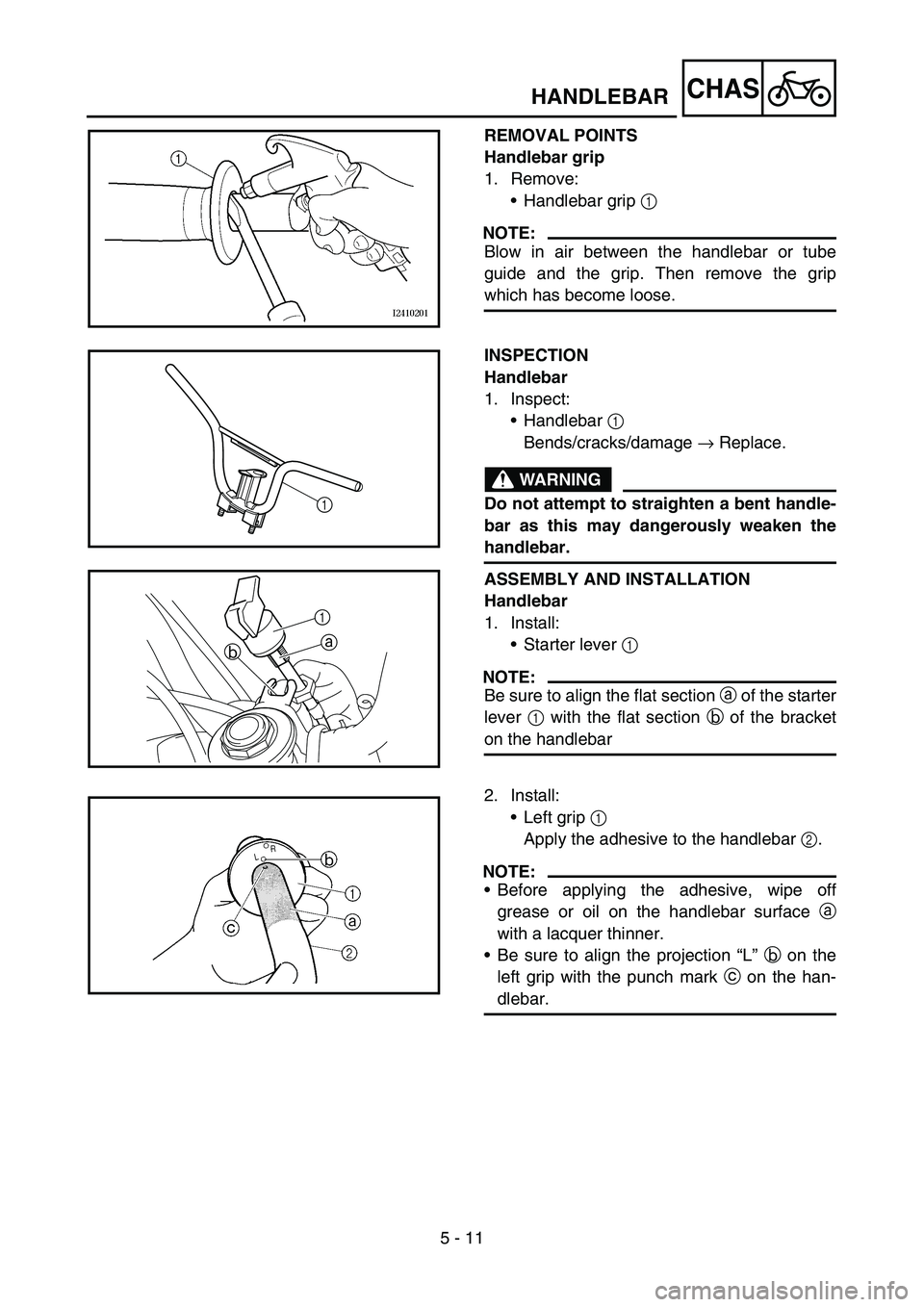
5 - 11
CHAS
REMOVAL POINTS
Handlebar grip
1. Remove:Handlebar grip 1
NOTE:
Blow in air between the handlebar or tube
guide and the grip. Then remove the grip
which has become loose.
INSPECTION
Handlebar
1. Inspect:
Handlebar 1
Bends/cracks/damage → Replace.
WARNING
Do not attempt to straighten a bent handle-
bar as this may dangerously weaken the
handlebar.
ASSEMBLY AND INSTALLATION
Handlebar
1. Install:
Starter lever 1
NOTE:
Be sure to align the flat section a of the starter
lever 1 with the flat section b of the bracket
on the handlebar
1
a
b 1
2. Install:
Left grip 1
Apply the adhesive to the handlebar 2.
NOTE:
Before applying the adhesive, wipe off
grease or oil on the handlebar surface a
with a lacquer thinner.
Be sure to align the projection “L ” b on the
left grip with the punch mark c on the han-
dlebar.
HANDLEBAR
Page 324 of 390
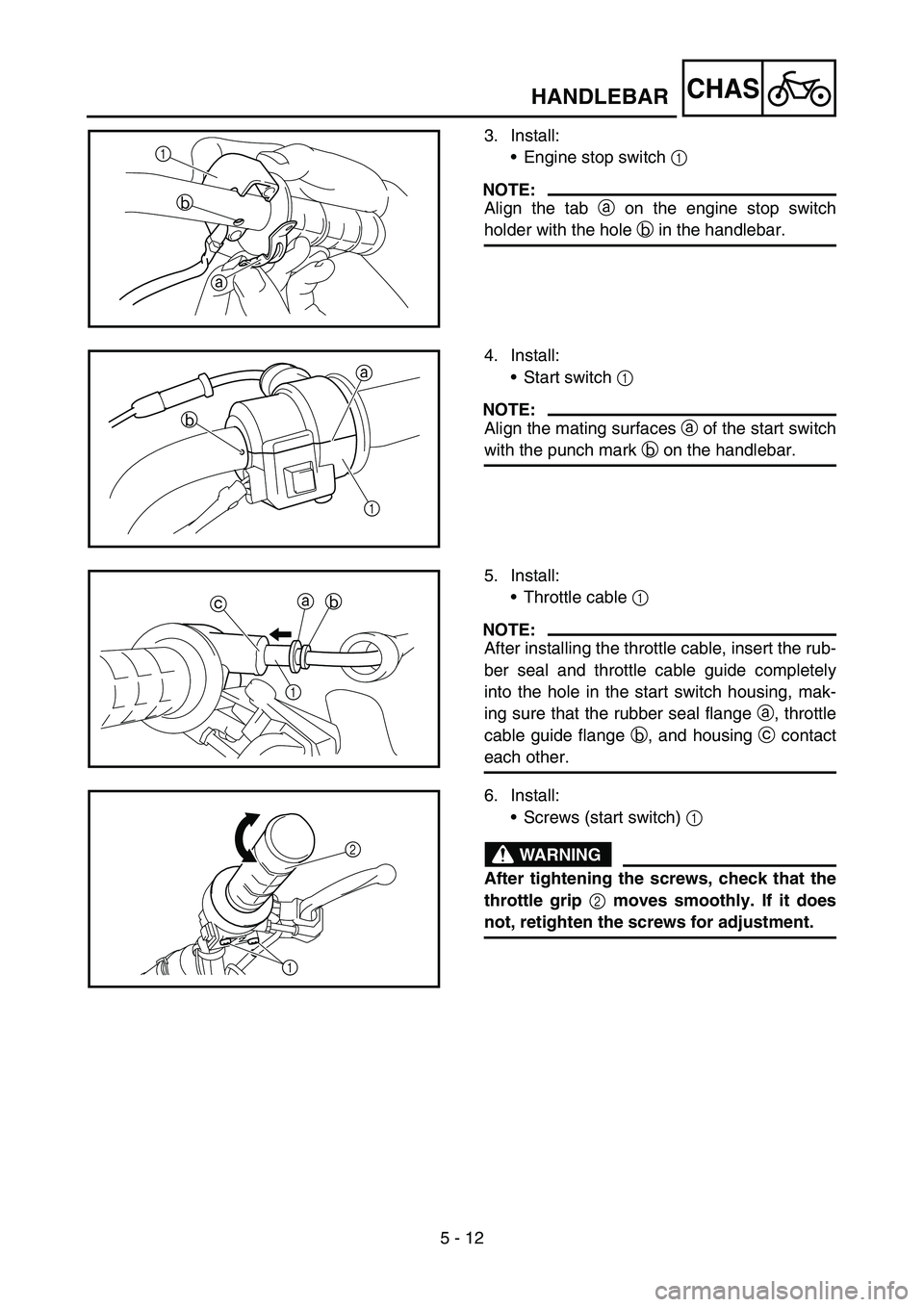
5 - 12
CHAS
3. Install:Engine stop switch 1
NOTE:
Align the tab a on the engine stop switch
holder with the hole b in the handlebar.
a
b
1
4. Install:
Start switch 1
NOTE:
Align the mating surfaces a of the start switch
with the punch mark b on the handlebar.
1
b a
5. Install:
Throttle cable 1
NOTE:
After installing the throttle cable, insert the rub-
ber seal and throttle cable guide completely
into the hole in the start switch housing, mak-
ing sure that the rubber seal flange a, throttle
cable guide flange b, and housing c contact
each other.
a
c b
1
6. Install:
Screws (start switch) 1
WARNING
After tightening the screws, check that the
throttle grip 2 moves smoothly. If it does
not, retighten the screws for adjustment.
2
1
HANDLEBAR